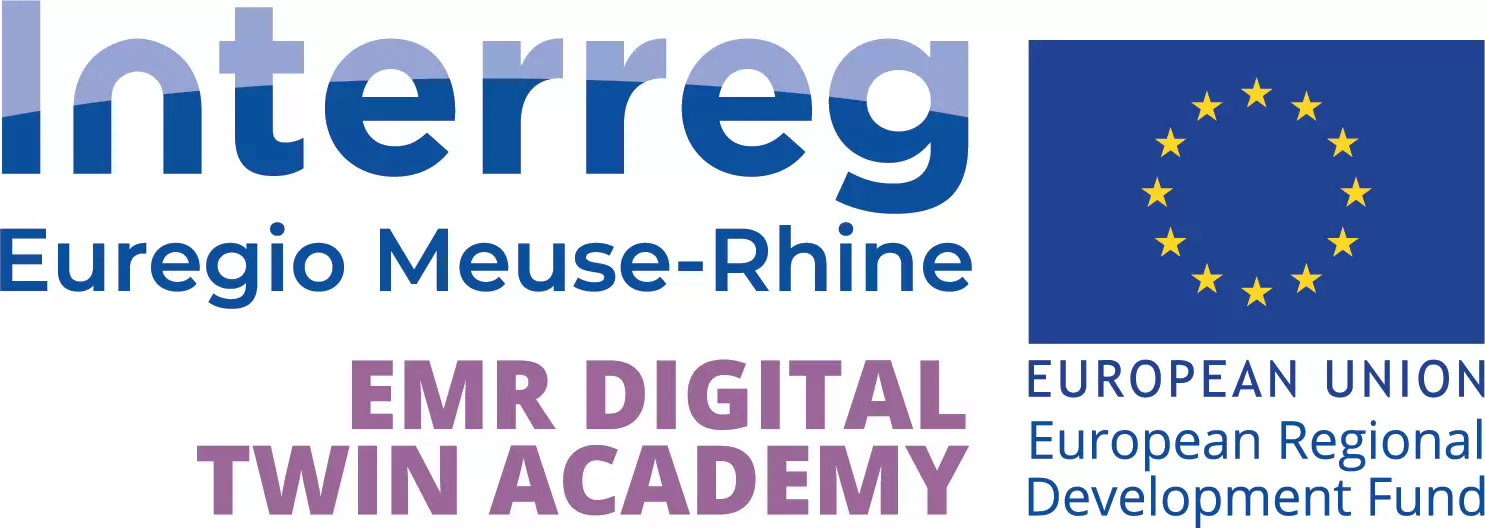

EMR Digital Twin Academy
Digital Twins are an important part of the latest industrial developments, often described as Industry 4.0 or Smart Industry
Onderdeel van:
A digital twin is more than a simulation, because it uses the data from the real machine: the so-called Industrial Internet of Things. The technology is far enough advanced for further application. A number of high-tech companies are already using digital twins in their design, development and maintenance processes. Besides application in smart industry, we also see opportunities for digital twins in other domains, such as the use to improve cities, healthcare and agriculture. The Digital Twin Academy project, carried out as an Interreg Euregio Meuse-Rhine (EMR) project, aims to open up this technology to a wider range of applications for SMEs.
The "Digital Twin Academy" project is a project funded by CALL6 of the Interreg V-a programme of the Meuse-Rhine Euregio. This programme is financed by the the European Regional Development Fund. This project also receives financial support from the regional authorities:
- La Fédération Wallonie-Bruxelles
- Province ofLimburg
- NRW- MWIDE
- Province of Noord-Brabant
- Wallonie
Research period: 2021-2023
Making Digital Twins applicable in SMEs
Digital twins have a number of specific applications that are already in use. But developing the technology for a specific function within a production process is costly and time-consuming because the broad applications of the technology have not yet been identified. To unlock this technology for the wider industry, the EMR Digital Twin Academy project was started as a cooperation between education, applied research and the business community in the Euroregion Meuse-Rhein. By working together on the application of digital twins, the cooperation functions as an acceleration trajectory, bringing together demand from the business world, research into applications and education and training.
The project has therefore also set a number of ambitious goals, which can be outlined as follows:
- Creating an ecosystem of excellence in the application and innovation of Digital Twin technology.
- Stimulating young people/ job seekers through Digital Twins to follow new careers with new companies in new professions related to technological innovation.
- Training students, CEOs, managers, employees, and the unemployed in digital twin technology with the latest innovations through blended and digital learning within a cross-border training programme. This programme must meet an ATAWAD standard of inclusiveness (accessible anytime, anywhere, on any device).
In summary, can we unlock digital twins for SMEs by bringing education, applied research and business together in a hybrid work format where applied research and knowledge sharing meets the (societal) needs?
General application:
The hybrid work form is increasingly seen as the future in research/education combined with acceleration for business. The EMR Digital Twin Academy project demonstrates how workable this approach is on a larger scale within a cross-border cooperation.
Methodology & findings
Within the broader project group, a variety of projects are being set up. As a University of Applied Sciences, Fontys is primarily involved in four lines of research and the development of online seminars/webinars. The subprojects within the EMR Digital Twin Academy focus on the development of a 'demonstrator' digital twin applications for various industries. Three lectorates of Fontys University of Applied Sciences ICT are working on this project together with two lectorates of Fontys institutes of Engineering and Transport & Logistics (Fontys Venlo).
The following projects have been initiated:
- Smart Industry Twin - a digital twin to connect mobile and robotic arms with an assembly system to show companies the possibilities of smart industry.
- Digital City Twin - a digital twin (in the Eindhoven and Parkstad region) to improve biodiversity in urban environments.
- Robot4Care - a simulation environment has already been developed with the Catharina hospital, which was very useful as a test environment for developers during the pandemic. The digital twin should help in robot-human interaction.
- Virtual Plant Twin - the application of digital twins in horticulture will help to monitor plant growth and predict harvest times.
Research team

Dr.ir. H.T. (Teade) Punter
Lector High Tech Embedded SoftwarePartners





